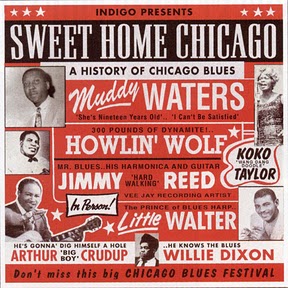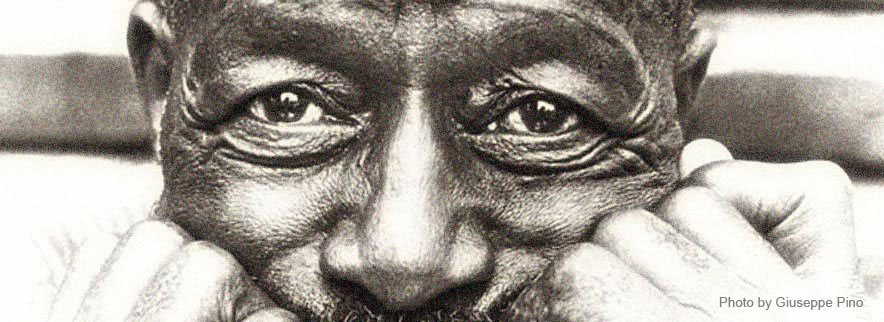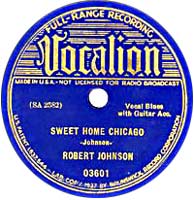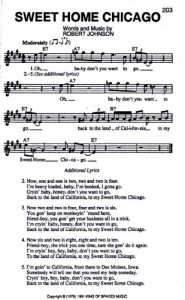There is perhaps no other song which is more iconic to the blues than “Sweet Home Chicago“. Is there any blues artist who doesn’t (didn’t) have it on his/her repertoire? At one time, more than 75 different versions of the song have been counted! Just try for fun looking up the song in any internet music store and browse through the different pages that are offered.
The song is at the same time a perfect illustration of many other aspects of the blues which all come together here: the sharing of common melodies and the rephrasing of lyrics using the same basic melody to compose a new song. It further mirrors the way that blues songs reflect the underlying social evolution and context. The song is finally a bitter example of the way that (some) whites have dealt with the copyrights to their own benefit and to the detriment of the artist or his/her legal heirs.

Let me explain.
The melodic roots of the song go way back in time and are virtually impossible to trace in the foggy history of traditionals and folk music. Was it white or was it black? Who will tell?
As for the genealogy of the lyrics there are different lines in the family tree (Encyclopedia of the Blues, Komara).
A first one is the ‘Honey Dripper’ line. The song is still very popular today; a very early version can be found already in a record by Edith North Johnson who was for the occasion accompanied by a pianist, Roosevelt Sykes, who would later put the song on his own repertoire (he would even be called “Mr Honeydripper” for his youthful prowess around girls, as Bill Dahl notes in his biographical notes on Sykes). A second line is the ‘Red Cross Blues’, which referred to the Red Cross stations which distributed food during the years of the Great Depression. The song is on the list of many past and present blues artists (a.o. Walter Davis, Walter Roland, Sonny Scot, Leadbelly, Mississippi Fred McDowell and Jerry Ricks).
There are other lyrical side lines (as for instance Leroy Carr’s: Baby don’t you love me no more), but the most well known, 3rd lyrical antecedent is however the ‘Kokomo Blues‘-line.
An early family member of this line is the Milk Cow Blues, recorded by Freddie Spruell in 1926 (Okeh Records), one of the first self-accompanied blues men whose song were waxed. Blind Blake has recorded it in 1927 under the title “One Time Blues”, transformed in 1928 by Arthur Petties in “Two Time Blues” (Petties is sometimes noted as Pettis, and he is known only for 6 recorded sides).
In 1927, in all its clumsiness (see my previous post : Commercial fever, clumsiness and sentimentality), Paramount issued “Kokola Blues” by Madlyn Davis, a powerful contemporary of the likes as Bessie Smith and Ma Rainey). What the white executives of Paramount wanted to publish was “Kokomo Blues” but they misspelled it as “Kokola Blues”.
Other versions of Kokomo Blues were recorded, one of the most famous being the one by “Kokomo” Arnold: “Old Original Kokomo Blues” who sung:
“Now one and one is two mama : two and two is four
Mess around here pretty mama : you know we got to goCrying oh : baby don’t you want to go
Back to the *living light* city : to sweet old Kokomo”.
This little city “Kokomo” in Indiana – some 200 km to the South East of Chicago – is of very little importance as a town with slightly more than 40.000 inhabitants a decade ago. Charlie McCoy however changed the geographical location of Kokomo by the more important town of Baltimore. He did so when recording the song in 1934 in Chicago. “Kokomo blues” became “Baltimore blues”. This song by McCoy may well be seen as a direct father of ‘Sweet Home Chicago”, which finally was made (world) famous by Robert Johnson.
Whilst the ‘Red Cross Blues’-version focused on the aspect of the local social aid during the Great Depression, the version that Robert Johnson recorded in 1936 clearly appealed to the social aspirations of the black population which wanted to seek the paradise elsewhere than in the South. In this respect it is important to note that the song went:
“Ooh, baby don’t you want to go
Ooh, baby don’t you want to go
Back to the land of California, To my sweet home Chicago”
Didn’t Robert Johnson know that Chicago was not a neighborhood city of California? Though Robert Johnson probably never went to Chicago, we can take it for granted that his geographical knowledge reached far enough to know that both cities were separated by more than 3.000 km. What makes more sense is to reason that Robert Johnson used the “confusion” California and Chicago deliberately and used it more in a metaphorical sense as the destination of the Great Migration, driven by the worsening conditions in the South and the injustice of the Jim Crow laws. In a historical perspective it is by the way funny to note that Robert Johnson referred in his song more to California than to Chicago, though the song grew popular in later time as homage to the City of Chicago. The reference to California was dropped completely: the phrase “Back to the land of California” was changed to “Back to the same old place“… The West Coast has also been the destination of a wave of migration but as a centre of the electric blues it has been surpassed by Chicago (West Coast blues has tended more towards jump blues, jazz and R&B).
When exploring the history of this classic blues song (which can be compared to Louis Armstrong’s “When the Saints” in the Jazz world), it is so striking to realize that the song can also serve as a perfect text book example of how blues music has been exploited by some white business men to make serious profit on the copyrights of blues artists. It is highly debatable whether there can be any copyrights whatsoever on this song, given the unclear roots of the song, both melodically as textually. However, this didn’t stop Steve Lavere from earning money each time that the song is played until today.
I won’t go into too much detail about this business man, captain of the “Delta Haze” company in Nevada, which manages the copyrights of many traditional blues artists (songs and pictures), of whom Robert Johnson is by far the most important one. Suffice it to say that Steve LaVere, one of the world’s most important collectors of vintage records, started his work in the sixties and can be considered as the most important researcher into the work and life of Robert Johnson. However, it is both morally as juridical highly disputable what he did to lay his hands on the copyrights of Johnson’s work. During his field work, he encountered an old woman whom he saw as the sole heir of the estate of Robert Johnson, and managed to acquire 50 % of the rights of his legacy. This appropriation was of more than symbolic nature: when the Robert Johnson’s complete recordings were reissued in 1990 the CD box sold more than a million copies and won a Grammy Award in 1991.
“Sweet home Chicago” must have a more than sweet taste to the wallet of Steve LaVere!




Fascinating.
You really must put this collection together one day in a book; I would order one immediately.
Best wishes,
Viv